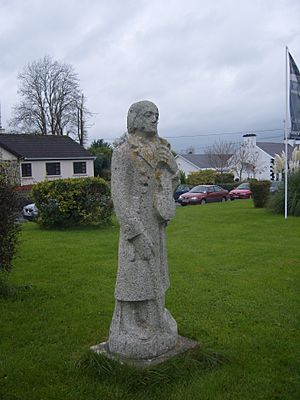Antoine Ó Raifteiri facts for kids
Quick facts for kids
Antoine Ó Raifteiri
|
|
|---|---|

Statue in Craughwell
|
|
| Born | 30 March 1779 Kiltimagh, County Mayo, Ireland |
| Died | December 25, 1835 (aged 56) Craughwell, County Galway, Ireland |
| Resting place | Killeeneen Cemetery, Craughwell |
| Language | Irish |
| Nationality | Irish |
| Genre | poetry |
| Notable works | Eanach Dhuin, Cill Aodain |
Antoine Ó Raifteirí (also known as Antoine Ó Reachtabhra or Anthony Raftery) was a famous Irish language poet. He lived from 1779 to 1835. Many people call him the last of the traveling poets, or "bards." He created beautiful poems and songs in Irish.
Contents
Life of Antoine Ó Raifteirí
Antoine Ó Raifteirí was born in a place called Killedan. This was near Kiltimagh in County Mayo, Ireland. His father worked as a weaver. He had moved from County Sligo to work for a local landlord, Frank Taaffe. Antoine's mother was from the Kiltimagh area. They had nine children in their family.
A Difficult Childhood
Antoine was a smart and curious child. But his life changed greatly between 1785 and 1788. A sickness called smallpox spread through his family. It caused a rash and high fever. Sadly, eight of his nine brothers and sisters died. Young Antoine also caught the illness. He lost his eyesight because of it. One of the last things he saw was his siblings lying dead.
Becoming a Wandering Poet
Antoine's father was a weaver, which meant their family wasn't the poorest. But it was harder for Antoine to find work because he was blind. He made a living by playing his fiddle. He also performed his songs and poems. He would visit the homes of rich Anglo-Irish families. His poems used the old ways of Irish poetry.
Like other poets of his time, Antoine had a patron. This was someone who supported him, like Frank Taaffe. One night, Antoine was riding one of Frank's horses. The horse got into an accident and died. Because of this, Frank sent Antoine away. Antoine then began his life as a traveling poet.
How His Poems Were Saved
Antoine Ó Raifteirí never wrote down his own poems. But he taught them to many people. Later, important people like Douglas Hyde and Lady Gregory collected them. They wrote down the poems from those who remembered them. This way, his amazing work was saved and published for everyone to read.
His Appearance and Final Days
Ó Raifteirí was thin and not very tall. But he was very strong. People thought he was a good wrestler. He usually wore a long coat and corduroy pants.
Antoine Ó Raifteirí died in 1835. He passed away at the home of Diarmuid Cloonan. This was in Killeeneen, near Craughwell in County Galway. He was buried in the nearby Killeeneen Cemetery. In 1900, Lady Gregory, Edward Martyn, and W.B. Yeats put a special stone on his grave. It simply said "RAFTERY." Today, there is a statue of him in Craughwell village.
His Famous Poems
Antoine Ó Raifteirí's most well-known poems are Eanach Chuin and Cill Aodain. Irish schoolchildren still learn these poems today.
Eanach Chúin
This poem is about a sad event. It tells the story of people who drowned from Anach Cuain.
|
Má fhaighimse sláinte is fada bheidh trácht |
If my health is spared I'll be long relating |
Cill Aodáin
These are the first two parts of "Cill Aodáin." It talks about traveling in spring.
|
Anois teacht an earraigh |
Now coming of the Spring |
His Legacy
Antoine Ó Raifteirí's work continues to be important today.
- The first four lines of his poem "Mise Raifteirí an File" were on the back of the Irish five-pound note.
|
Mise Raifteirí, an file, |
I am Raifteirí, the poet, |
- The writer James Stephens translated some of Ó Raifteirí's poems into English. An American composer, Samuel Barber, even used three of these translated poems for a musical piece.
- Every year, a festival called Féile Raifteirí is held. It takes place in Loughrea, County Galway, in late March. The festival celebrates Irish arts and poetry. It ends with a visit to Raifteirí's grave.
- In Kiltimagh town square, there is a granite memorial for Antoine Ó Raifteirí. It was put there in 1985. That same year, Kiltimagh became "twinned" with Craughwell, where the poet is buried.
- Scoil Raifteirí, an Irish-language primary school in Castlebar, County Mayo, is named after him.
- A restaurant in Kiltimagh is called The Raftery Room Restaurant.
- Antoine Ó Raifteirí is mentioned in a 1975 novel by Jack Higgins called The Eagle Has Landed.
- In 2011, a movie about his life was made. It was called Mise Raiftearaí an Fíodóir Focal (which means I am Raifteirí, The Weaver of Words).
- A street in Derry, Northern Ireland, is named Raftery Close. All the streets in that area are named after Irish writers.
- In Radclyffe Hall's novel The Well of Loneliness, a horse is named Raftery after the poet.
- Some people think Bob Dylan's 2020 song "I Contain Multitudes" refers to one of Raifteirí's poems.

